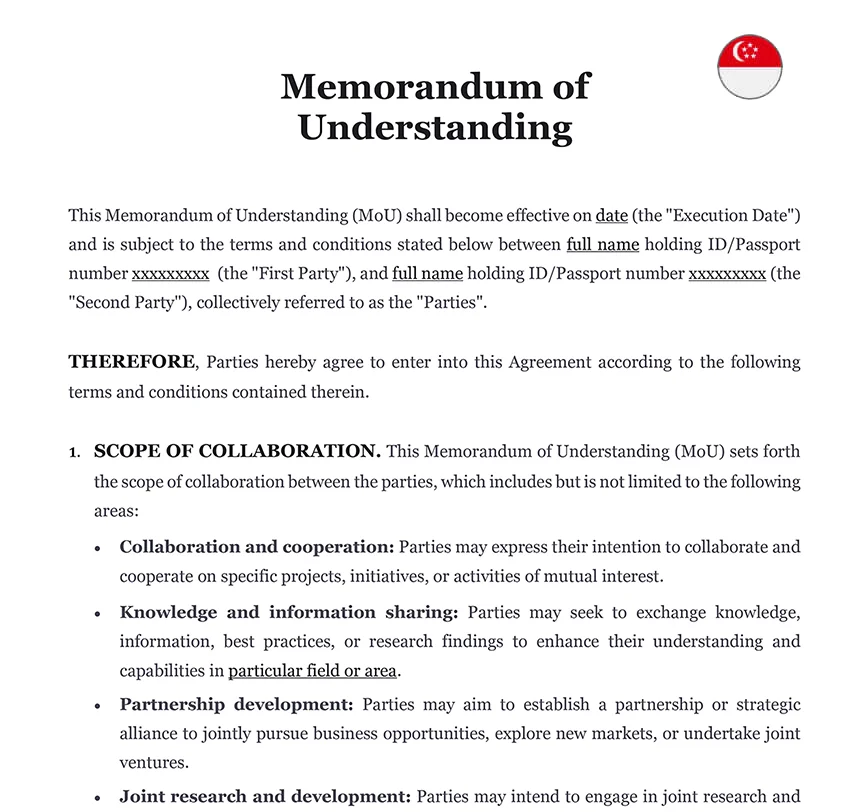Ready to use legal template
Drafted by experienced lawyers
Compliant with Singapore law
Ready to use legal template
Drafted by lawyers
Compliant with Singapore law
Home › Business contract › Memorandum of Understanding
Learn more about Memorandum of Understanding in Singapore
Looking for a comprehensive Memorandum of Understanding (MoU) in Singapore? Discover Themis Partner’s easy-to-edit MoU template drafted by experienced lawyers to meet the requirements of Singaporean law. Our Memorandum of Understanding is designed to define the duties, responsibilities, and expectations in a collaboration or partnership. It covers essential aspects such as confidentiality, financial matters, and dispute resolution mechanisms, ensuring a fair and transparent working relationship. With Themis Partner’s MoU template, you can establish a solid foundation for your collaboration and protect the interests of all parties involved.
Table of contents
What is a Memorandum of Understanding (MoU)?
A Memorandum of Understanding (MoU) in Singapore is a written document that outlines the mutual understanding and intentions between two or more parties to collaborate on a specific project, venture, or initiative. It serves as a preliminary agreement that sets the framework for future cooperation and establishes the goals, roles, and responsibilities of each party involved.
ℹ️ While not legally binding like a Partnership Agreement, an MoU is still an important tool for fostering trust and ensuring clarity among the parties. It outlines the objectives, scope, and duration of the collaboration, as well as any financial or resource commitments.
While an MoU lays the foundation for a partnership, it is distinct from a partnership agreement in that it focuses on the understanding and cooperation between parties rather than creating a formal legal entity or specifying the legal rights and obligations associated with a partnership.
What are the key elements included in it?
1. Parties Involved
The names and contact information of the parties involved in the agreement are clearly stated, including their legal status or representation.
2. Collaboration Purpose
The MoU defines the purpose and objectives of the collaboration, outlining the common goals and desired outcomes.
3. Scope of Collaboration
The scope of the collaboration is described, specifying the activities, projects, or areas that will be covered by the agreement.
4. Roles and Responsibilities
The respective roles and responsibilities of each party are defined, clarifying their contributions, tasks, and obligations.
5. Duration
The period of validity or duration of the MoU is specified, indicating the start and end dates or any provisions for renewal or termination.
6. Resources and Financial Commitment
Any commitments of resources, funding, or other contributions from each party are outlined, including any cost-sharing arrangements or financial obligations.
7. Governance and Decision-making
The decision-making process and governance structure for the collaboration are established, including mechanisms for resolving disputes or conflicts.
8. Confidentiality
The MoU may include provisions to protect the confidentiality of sensitive information shared during the collaboration, outlining the obligations and restrictions related to confidentiality.
The MoU is typically signed by authorised representatives of each party, indicating their agreement to the terms and conditions outlined in the document.
How does it differ from a formal contract?
It differs from a formal contract in several ways. While both documents serve as written agreements, an MoU is generally less formal and binding than a formal contract.
| ➤ An MoU focuses on establishing a mutual understanding and intention between parties to collaborate or cooperate on a specific project or endeavour. It sets out the goals, objectives, and general framework of the collaboration, outlining the key elements of the partnership. |
| ➤ In contrast, a formal contract is a legally binding agreement that typically contains specific terms and conditions, including the rights, obligations, and remedies of each party involved. A contract is more comprehensive and detailed, addressing legal aspects such as payment terms, performance obligations, and dispute resolution mechanisms. |




